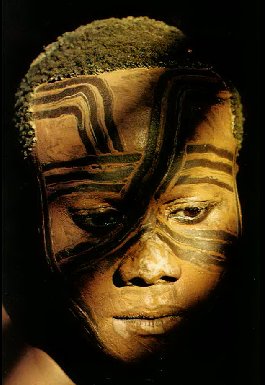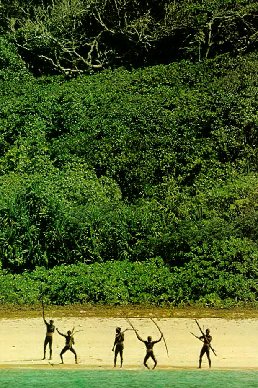Last of the Savages. Lost Forever
Raghubir Singh/National Geographic

The Islands of Andaman and Nicobar in the Indian ocean were said to be home to the last of the savages. The Tsunami of December 26th has completely wiped those aboriginals and the only way left for us to study them is through the research prior published. So for those interested about learning about the natives of Andaman Islands, I suggest the following resources.
The National Geographic feature especially, has some great pictures by late Raghubir Singh. My favorite one is the one where the natives are dancing with joy (shown below) as the photographer's boat pulled away, as if to celebrate banishing of the evil.

The Islands of Andaman and Nicobar in the Indian ocean were said to be home to the last of the savages. The Tsunami of December 26th has completely wiped those aboriginals and the only way left for us to study them is through the research prior published. So for those interested about learning about the natives of Andaman Islands, I suggest the following resources.
The National Geographic feature especially, has some great pictures by late Raghubir Singh. My favorite one is the one where the natives are dancing with joy (shown below) as the photographer's boat pulled away, as if to celebrate banishing of the evil.
Raghubir Singh/National Geographic
| Title: | The Last Andaman Islanders |
| Author: | Singh Raghubir |
| Publication: | National Geographic Magazine |
| Enumeration: | July 1975, pp. 66-91 |
| Abstract: | Ethnology of the last remaining tribes of Andaman island in India. Covers Jarawa, Negrito, Onge, and
Sentinelese tribals and their primitive lifestyles. Source of Abstract: Written by Kamat Editorial Team |
![]()
| Title: | Policing the Savage: Segregation, Labor and State Medicine in the Andamans |
| Author: | Sen, Satadru |
| Publication: | The Journal of Asian Studies |
| Enumeration: | v. 58 no. 3 (August 1999) p. 753-73 |
| Abstract: | A discussion of the colonial policies and practices the British directed at Andaman islanders in India in the second half of the 19th century. The writer focuses on three areas of colonial intervention--segregation, work, and medical practices--in order to demonstrate the tensions inherent in the British "colonizing" projects of disciplining thousands of Indian convicts sent to the island and of "civilizing" several thousand Andamnese tribals. Source of Abstract: Provided by Publisher |
![]()
| Title: | The Last Island of the Savages |
| Author: | Goodheart, Adam |
| Publication: | The American Scholar |
| Enumeration: | v. 69 no. 4 (Autumn 2000) p. 13-44 |
| Abstract: | When the Panamanian-registered freighter the Primrose became stranded off the shore of North Sentinel Island in the Andaman archipelago in 1981, its predicament seemed a thing of the 18th century. The inhabitants of the island had had almost no contact with the rest of humanity and, although anthropologists called them "Sentinelese," nobody knew how they referred to themselves or even what language they spoke. Neither did anyone know whether their primitive state was one of savagery or innocence. Although there is no apparently simple explanation for the island's isolation, the place had little appeal until it became a historical curiosity as the last place on earth where the Age of Discovery could play out its tragedy and farce. The writer discusses the history of North Sentinel Island and efforts to study the Andamanese aborigines. Source of Abstract: Provided by Publisher |
![]()
| Title: | Flaked glass tools from the Andaman Islands and Australia |
| Authors: | Cooper, Zarine and Bowdler, Sandra |
| Publication: | Asian Perspectives |
| Enumeration: | v. 37 no. 1 (Spring 1998) p. 74-83 |
| Abstract: | The writers describe flaked glass artifacts from archaeological contexts in the Andaman Islands and several widely separated regions of Australia. They review the general problems in the identification of these kinds of artifacts, considering them also in the light of the 19th-century ethnohistoric records from both areas describing their use and manufacture. They attribute similarities in their mode of manufacture to the deployment of the fundamental processes involved in flaking (knapping) behavior when similar new materials are available. Source of Abstract: Provided by Publisher |
![]()
